
gardening
16
K living
seasons. This will guide the
designer towards creating a
planting scheme that will not only
be beautiful to look at but will
also thrive in those surroundings.
You can take many years to
create the garden of your dreams,
but the important thing is to have
a master plan to work from. Even
if this is all you can afford to do at
the moment, it will be money well
spent. A master plan first needs a
technical survey; this will provide
the designer with a drawing of
the garden to scale, showing
boundaries, any permanent
features, contours, levels and so
forth. A good designer will then
talk to you at length about what
you most want from your garden,
in terms of both function and
aesthetics.
Your chosen designer should
ask you a lot of questions about
what you want from the garden in
terms of practicality: who is going
to use it, when will it be most
used, what will it be used for and
so on. It is also helpful if you can
sort out priorities: a vegetable
garden, for example, may be at
the very top of your own list,
whereas your partner may be
dreaming of a new driveway and
your children of a tree house.
With the designer’s help, you
should be able to decide the order
in which work should be done.
There is no point planting a
beautiful lawn if in two years’
time you are planning to drive
heavy machinery over it to build
a gazebo.
There is very often a
misunderstanding about gardens
compared to houses: people
expect their construction to be
simpler. In fact they are equally
complicated. Just as you would
not hang the curtains and then
decide to do the rewiring or
replumbing, so in a garden you
have to make sure that all your
essential services are in place
before you begin planting. The
garden designer may well
recommend that you budget for
a lighting designer from the start,
because lighting has an incredible
impact. It not only allows you to
extend the hours for which you
use a garden – maximizing your
enjoyment of it – but it also
brings atmosphere, interest and
personality into your outdoor
space. You may not be able to
afford all the lighting features you
would like at the very beginning,
but you want to have all the
cables laid so that it is easy to add
lighting features at a later date.
Once you have essential
services in the right positions
and have agreed a logical order
and timescale for the garden’s
transformation, you can begin
to tackle questions of style, with
your designer’s help: type of
boundary (wall, fence, hedge);
size, style and colour of hard
surfaces (paving stones, decking,
gravel), planting schemes… Again
there is a parallel with interior
design: boundaries are the walls;
hard surfaces the floors; planting
schemes the soft furnishings.
A
competent garden designer
will encourage you to view
your garden as a series of
rooms, rather than one big space.
There are decisions to be made
not only about how you access the
garden from different points of the
house but about how you travel
around the garden; the connection
of different levels and different
‘rooms’; the enjoyment of views
in all directions; the change of
surfaces underfoot to signify a
different mood; the focal points
within a space, be they natural
ones such as mature trees or
man-made ones such as sculpture
or gazebos. Even a tiny garden
A well-designed
garden will be an
investment, for
great gardens
add enormously
to both the value
and saleability of
a property
Randle Siddeley,
who also holds
the title of The
Lord Kenilworth,
is internationally
renowned for
his gardening
expertise. His
book, GARDEN,
is published in
May by Frances
Lincoln, at £45
needs careful consideration in
order to ‘zone’ it appropriately
– where is the seating area, the
visual interest, the traffic route?
Be bold and brave when it
comes to the design of your
garden. Too often people get
locked into certain ideas, because
these reflect the way the garden
has always looked: a terrace by
the house, a bit of lawn, some
flower beds.
You may think you want to
keep the essential structure of your
garden and simply ask a designer
to refresh it in some way. But if he
or she sees other possibilities, a
way of reconfiguring the space to
improve both the way it is used
and the way it looks, open your
mind to their suggestions. The
most successful schemes are
probably those where a designer
is able to strip out everything
(except protected trees) and begin
again – a blank canvas. You have
to trust the eye of the professional
you have hired. Landscape
designers spend many years
learning their craft; they will be
more able than you are to see
what could be created within the
given space.
A well-designed garden will be
an investment, for great gardens
add enormously to both the value
and saleability of a property.
However, the fact is that if you
design a garden that is perfect for
you, you will probably never want
to move again.
l
Foreword by
DAVID LINLEY
GARDEN
RANDLE SIDDELEY


